Estimating the Spatial Accessibility to Blood Group and Rhesus Type Point-of-Care Testing for Maternal Healthcare in Ghana
Abstract
1. Introduction
2. Methods
2.1. Overview
2.2. Spatial Data of Health Facilities
2.3. Geospatial Analysis
Developing a Model for Estimating the Travel Time
2.4. Buffer
2.5. Spatial Autocorrelation
2.6. Ethics Approval
3. Results
3.1. Characteristics of the Health Facilities Providing Blood Group and Rhesus Type POC Testing
3.2. Spatial Distribution of Health Facilities Providing Blood Grouping and Rhesus Type Testing Services in the UER
3.3. Spatial Accessibility to Blood Group and Rhesus Type Testing in the UER
4. Discussion
5. Conclusions
Supplementary Materials
Author Contributions
Acknowledgments
Conflicts of Interest
Abbreviations
| ANC | Antenatal care |
| CHAG | Christian Health Association of Ghana |
| DEM | Digital elevation model |
| GHS | Ghana Health Service |
| GIS | Geographic Information Systems |
| PHC | Primary healthcare |
| POC | Point-of-care |
| SSA | Sub-Saharan Africa |
| UER | Upper East Region |
| WHO | World Health Organisation |
References
- World Health Organisation. More Women and Children Survive Today than ever before—UN Report. Available online: https://www.who.int/news-room/detail/19-09-2019-more-women-and-children-survive-today-than-ever-before-un-report (accessed on 20 September 2019).
- World Health Organization. Trends in Maternal Mortality: 2000 to 2017: Estimates by WHO, UNICEF, UNFPA, World Bank Group and the United Nations Population Division. Available online: http://documents.worldbank.org/curated/en/793971568908763231/pdf/Trends-in-maternal-mortality-2000-to-2017-Estimates-by-WHO-UNICEF-UNFPA-World-Bank-Group-and-the-United-Nations-Population-Division.pdf (accessed on 21 September 2019).
- Say, L.; Chou, D.; Gemmill, A.; Tuncalp, O.; Moller, A.B.; Daniels, J.; Gulmezoglu, A.M.; Temmerman, M.; Alkema, L. Global causes of maternal death: a WHO systematic analysis. Lancet Glob. Health 2014, 2, e323–e333. [Google Scholar] [CrossRef]
- Ramani, K.V.; Mavalankar, D.V.; Govil, D. Study of blood-transfusion services in Maharashtra and Gujarat States, India. J. Health Popul. Nutr. 2009, 27, 259–270. [Google Scholar] [CrossRef] [PubMed]
- World Health Organization. Blood Transfusion Safety. Available online: https://www.who.int/bloodsafety/testing_processing/components/en/ (accessed on 16 October 2019).
- Guagliardo, M.F. Spatial accessibility of primary care: concepts, methods and challenges. Int. J. Health Geogr 2004, 3, 3. [Google Scholar] [CrossRef] [PubMed]
- Gething, P.W.; Johnson, F.A.; Frempong-Ainguah, F.; Nyarko, P.; Baschieri, A.; Aboagye, P.; Falkingham, J.; Matthews, Z.; Atkinson, P.M. Geographical access to care at birth in Ghana: a barrier to safe motherhood. BMC Public Health 2012, 12, 991. [Google Scholar] [CrossRef] [PubMed]
- Arthur, E. Wealth and antenatal care use: implications for maternal health care utilisation in Ghana. Health Econ. Rev. 2012, 2, 14. [Google Scholar] [CrossRef] [PubMed]
- Kuupiel, D.; Bawontuo, V.; Mashamba-Thompson, T.P. Improving the Accessibility and Efficiency of Point-of-Care Diagnostics Services in Low- and Middle-Income Countries: Lean and Agile Supply Chain Management. Diagnostics 2017, 7, 58. [Google Scholar] [CrossRef] [PubMed]
- Tanser, F.; Gijsbertsen, B.; Herbst, K. Modelling and understanding primary health care accessibility and utilization in rural South Africa: An exploration using a geographical information system. Soc. Sci. Med. (1982) 2006, 63, 691–705. [Google Scholar] [CrossRef] [PubMed]
- MacKinney, A.; Coburn, A.; Lundblad, J.; McBride, T.; Mueller, K.; Watson, S. Access to Rural Health Care–A Literature Review and New Synthesis. Policy Report. Rupri: Rural Policy Res. Inst. 2014. Available online: https://www.rupri.org/?library=access-to-rural-health-care-a-literature-review-and-new-synthesis-report-prepared-by-the-rupri-health-panel-august-2014 (accessed on 16 October 2019).
- Kuupiel, D.; Adu, K.M.; Apiribu, F.; Bawontuo, V.; Adogboba, D.A.; Ali, K.T.; Mashamba-Thompson, T.P. Geographic accessibility to public health facilities providing tuberculosis testing services at point-of-care in the upper east region, Ghana. BMC Public Health 2019, 19, 718. [Google Scholar] [CrossRef] [PubMed]
- Kuupiel, D.; Adu, K.M.; Bawontuo, V.; Mashamba-Thompson, T.P. Geographical Accessibility to District Hospitals/Medical Laboratories for Comprehensive Antenatal Point-of-Care Diagnostic Services in the Upper East Region, Ghana. E. Clin. Med. 2019, 13, 74–80. [Google Scholar] [CrossRef] [PubMed]
- Ameyaw, E.K.; Kofinti, R.E.; Appiah, F. National health insurance subscription and maternal healthcare utilisation across mothers’ wealth status in Ghana. Health Econ. Rev. 2017, 7, 16. [Google Scholar] [CrossRef] [PubMed]
- Ghana Statistical Service, G.H.S.; ICF. Ghana Maternal Health Survey 2017: Key Findings. Available online: https://dhsprogram.com/pubs/pdf/SR251/SR251.pdf (accessed on 24 April 2019).
- Asamoah, B.O.; Moussa, K.M.; Stafström, M.; Musinguzi, G. Distribution of causes of maternal mortality among different socio-demographic groups in Ghana; A descriptive study. BMC Public Health 2011, 11, 159. [Google Scholar] [CrossRef] [PubMed]
- Der, E.M.; Moyer, C.; Gyasi, R.K.; Akosa, A.B.; Tettey, Y.; Akakpo, P.K.; Blankson, A.; Anim, J.T. Pregnancy Related Causes of Deaths in Ghana: A 5-Year Retrospective Study. Ghana Med. J. 2013, 47, 158–163. [Google Scholar] [PubMed]
- Ministry of Health; Ghana Health Service. Maternal Health Record Book; Reproduction and Child Health, Ed.; Ministry of Health: Accra, Ghana, 2016; p. 4. [Google Scholar]
- Republic of Ghana; Ghana Health Service. A guide for maternal and newborn care part one: Maternal care.
- Kuupiel, D.; Tlou, B.; Bawontuo, V.; Mashamba-Thompson, T.P. Accessibility of pregnancy-related point-of-care diagnostic tests for maternal healthcare in rural primary healthcare facilities in Northern Ghana: A cross-sectional survey. Heliyon 2019, 5, e01236. [Google Scholar] [CrossRef] [PubMed]
- World Health Organization. Second WHO Model List of Essential In Vitro Diagnostics. Available online: https://www.who.int/medical_devices/publications/Second_WHO_Model_List_of_Essential_In_Vitro_Diagnostics/en/ (accessed on 21 September 2019).
- Becher, H.; Muller, O.; Jahn, A.; Gbangou, A.; Kynast-Wolf, G.; Kouyate, B. Risk factors of infant and child mortality in rural Burkina Faso. Bull. World Health Organ. 2004, 82, 265–273. [Google Scholar] [PubMed]
- Anselin, L. Spatial Data Analysis with GIS: An Introduction to Application in the Social Sciences. Available online: https://escholarship.org/uc/item/58w157nm#main (accessed on 20 September 2019).
- Environment Systems Research Institute. How Spatial Autocorrelation (Global Moran’s I) works. Available online: https://pro.arcgis.com/en/pro-app/tool-reference/spatial-statistics/h-how-spatial-autocorrelation-moran-s-i-spatial-st.htm (accessed on 26 September 2019).
- Brondeel, R.; Weill, A.; Thomas, F.; Chaix, B. Use of healthcare services in the residence and workplace neighbourhood: The effect of spatial accessibility to healthcare services. Health Place 2014, 30, 127–133. [Google Scholar] [CrossRef] [PubMed]
- Ferguson, W.J.; Kemp, K.; Kost, G. Using a geographic information system to enhance patient access to point-of-care diagnostics in a limited-resource setting. Int. J. Health Geogr. 2016, 15, 10. [Google Scholar] [CrossRef] [PubMed]
- Mitra, R.; Mishra, N.; Rath, G.P. Blood groups systems. Indian J. Anaesth 2014, 58, 524–528. [Google Scholar] [CrossRef] [PubMed]
- Patel, A.; Waters, N. Using geographic information systems for health research. In Application of Geographic Information Systems; IntechOpen: London, UK, 2012. [Google Scholar]
- Dangisso, M.H.; Datiko, D.G.; Lindtjorn, B. Accessibility to tuberculosis control services and tuberculosis programme performance in southern Ethiopia. Glob. Health Action 2015, 8, 29443. [Google Scholar] [CrossRef] [PubMed]
- Kost, G. Theory, principles, and practice of optimizing point-of-care small-world networks. Point Care 2012, 11, 96–101. [Google Scholar] [CrossRef]
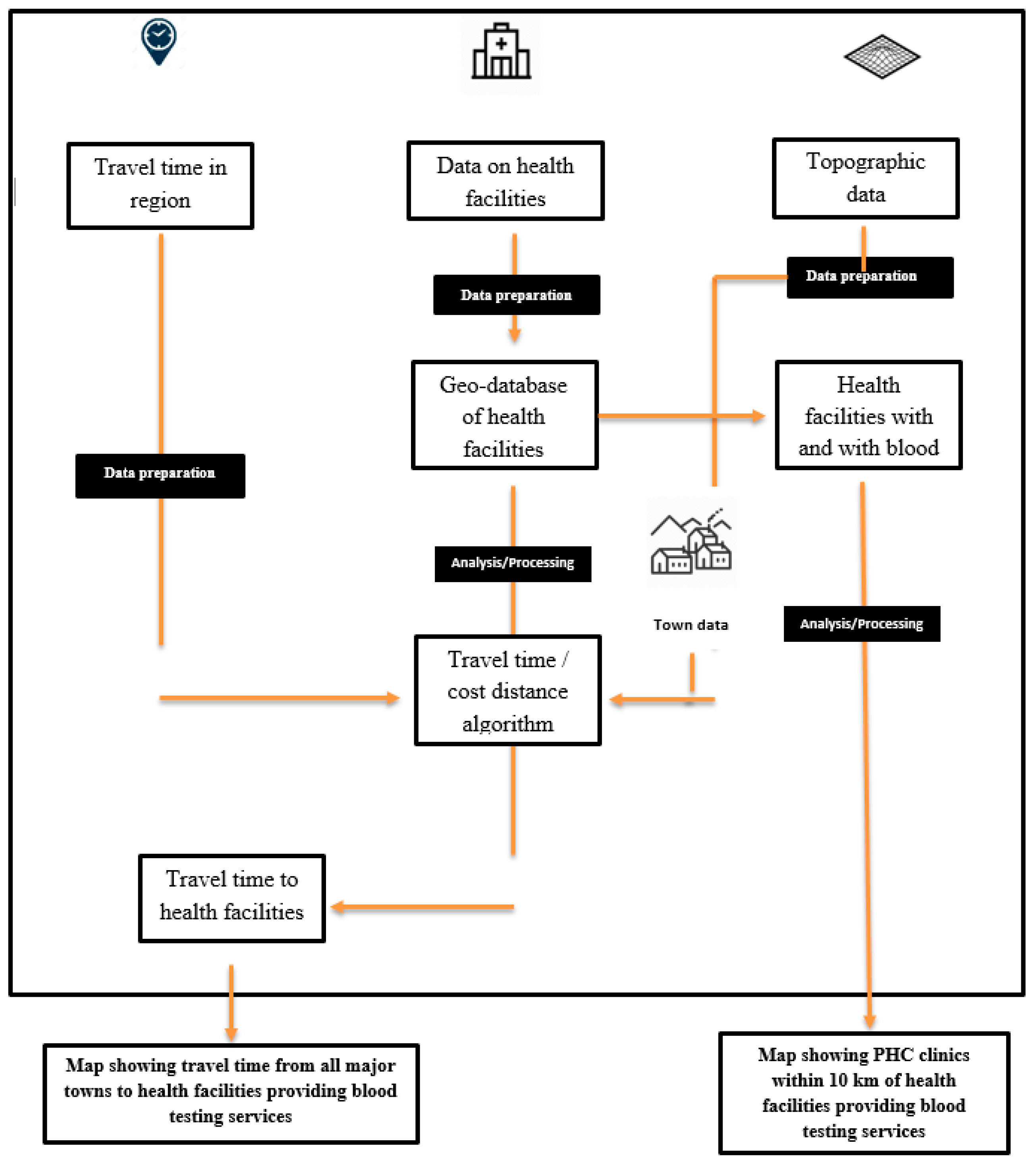
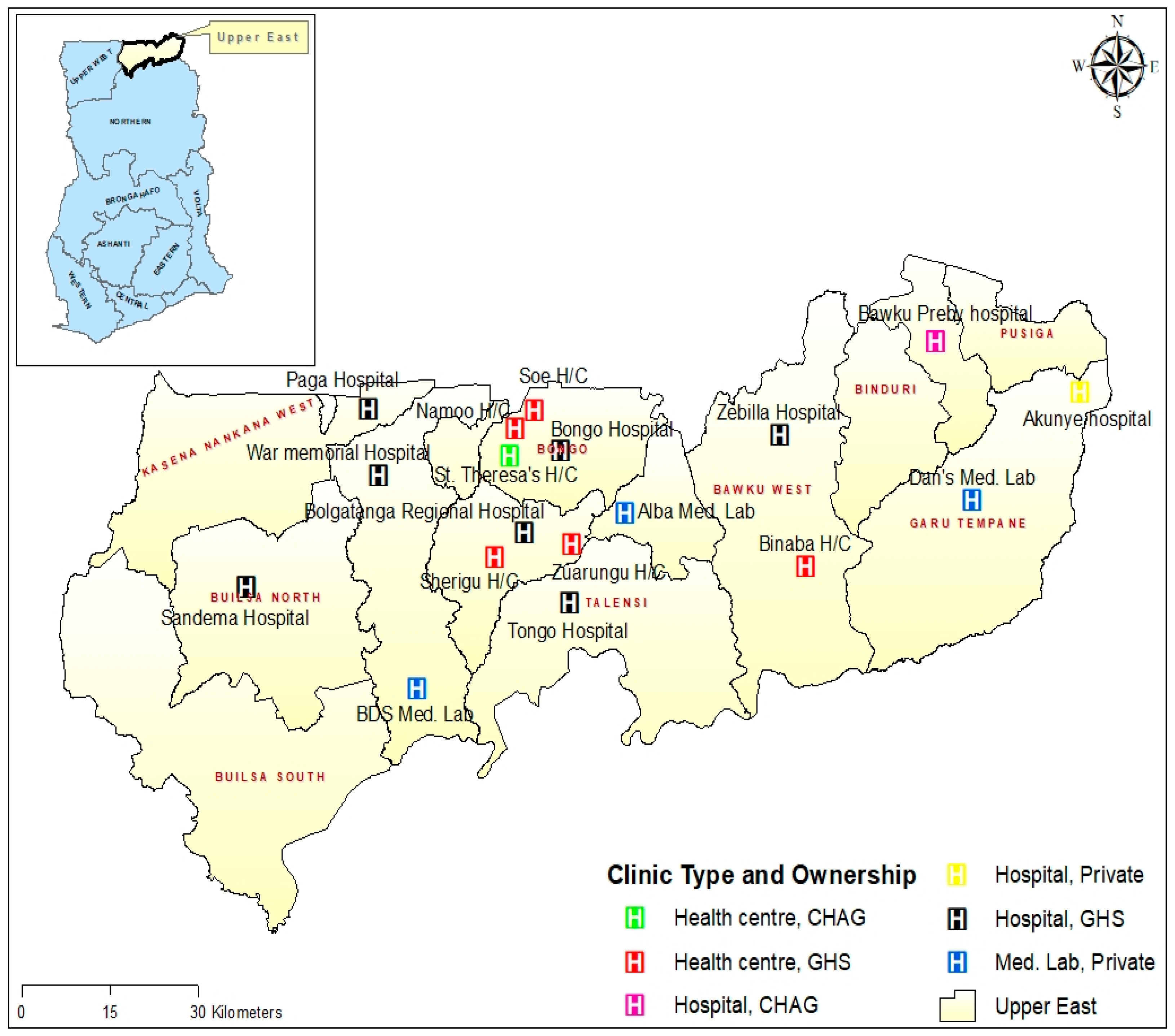
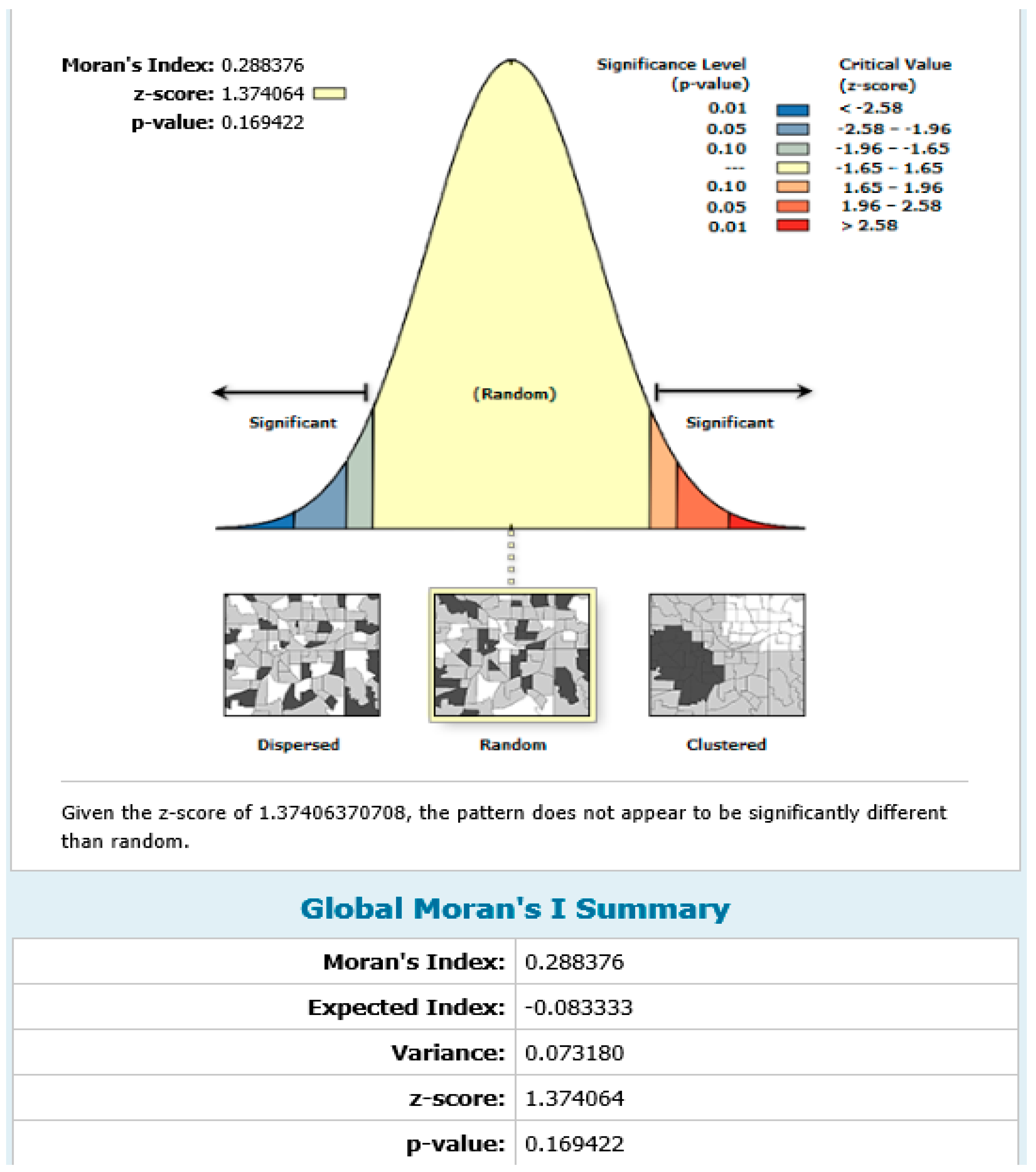
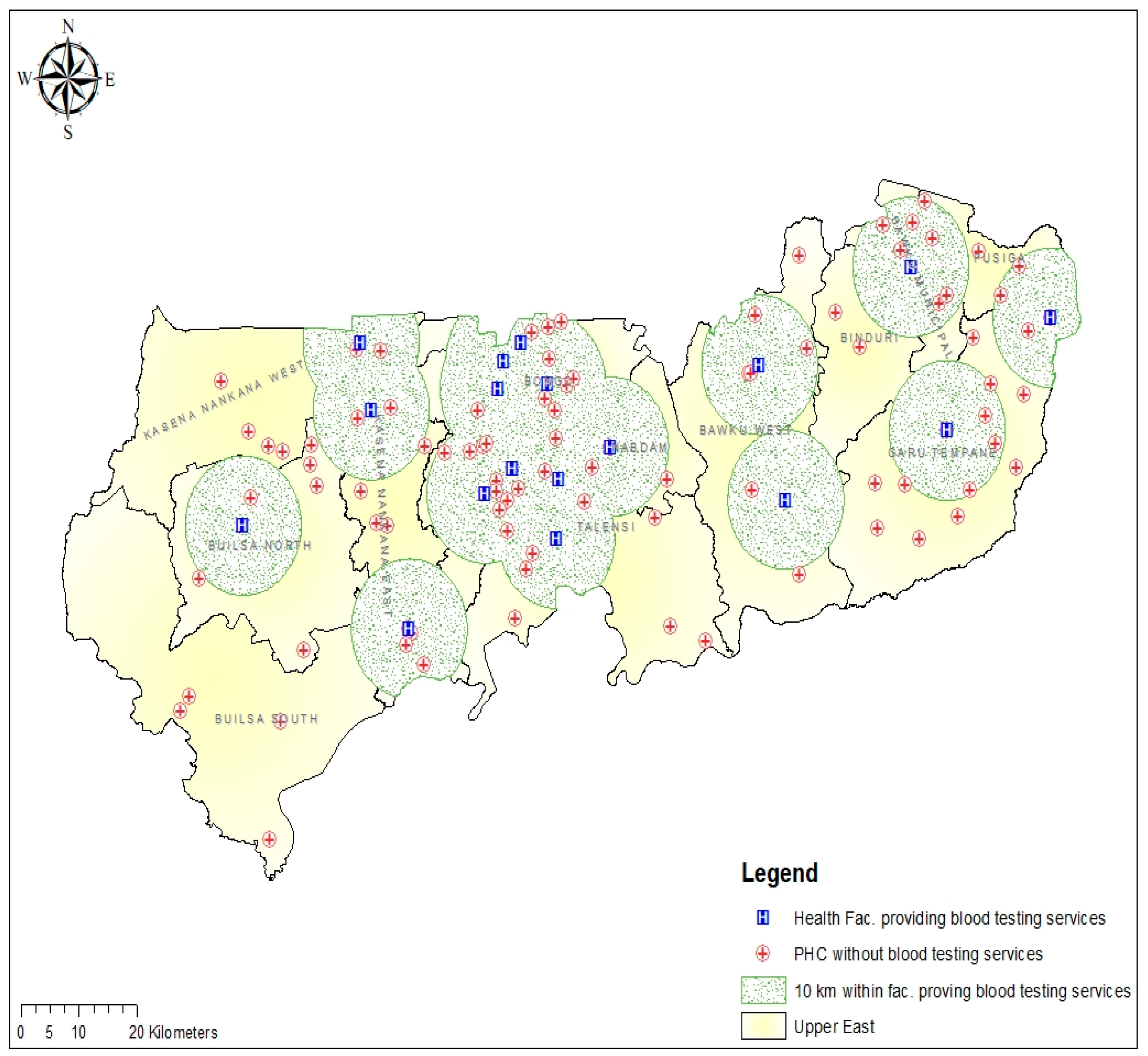
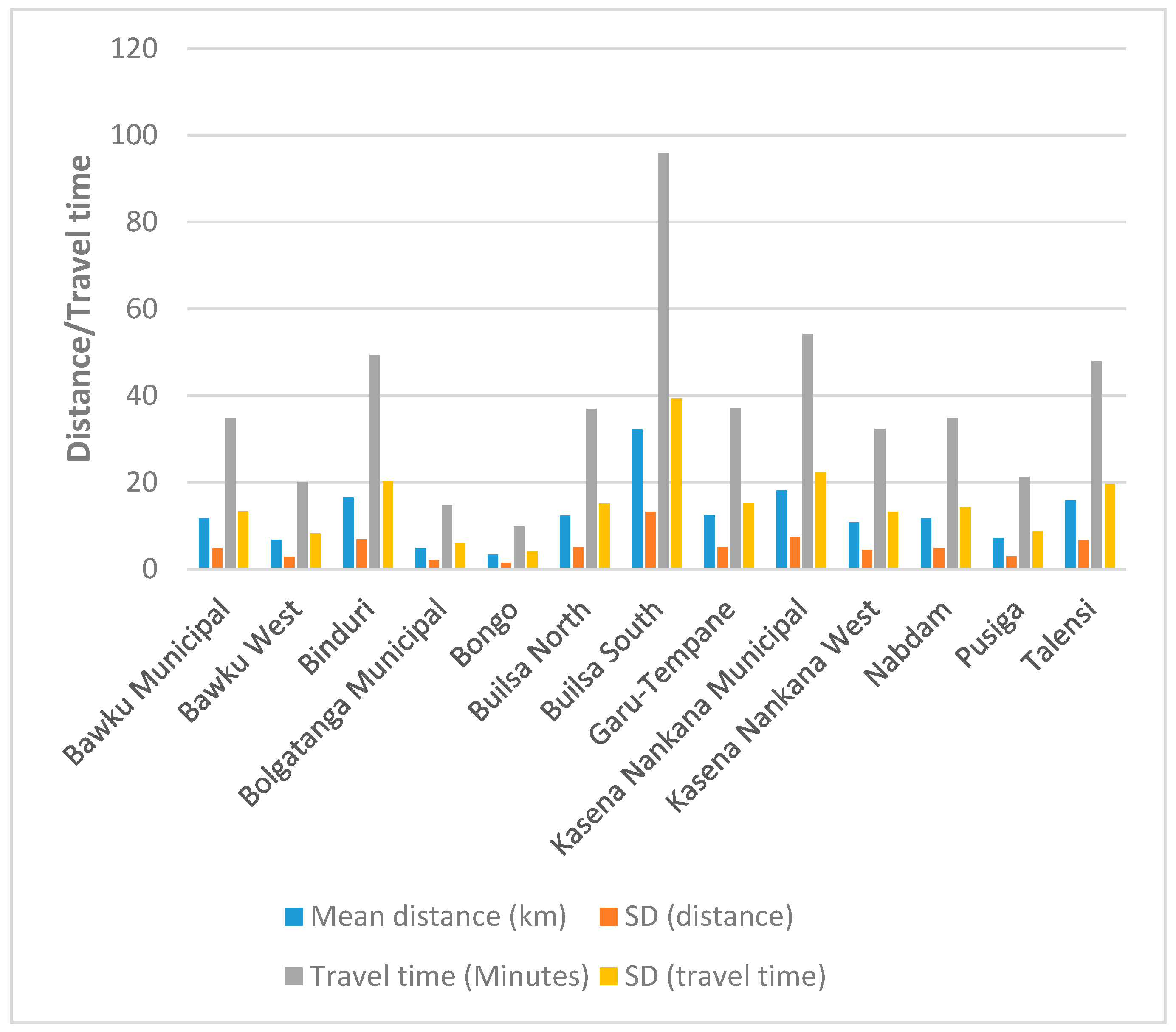
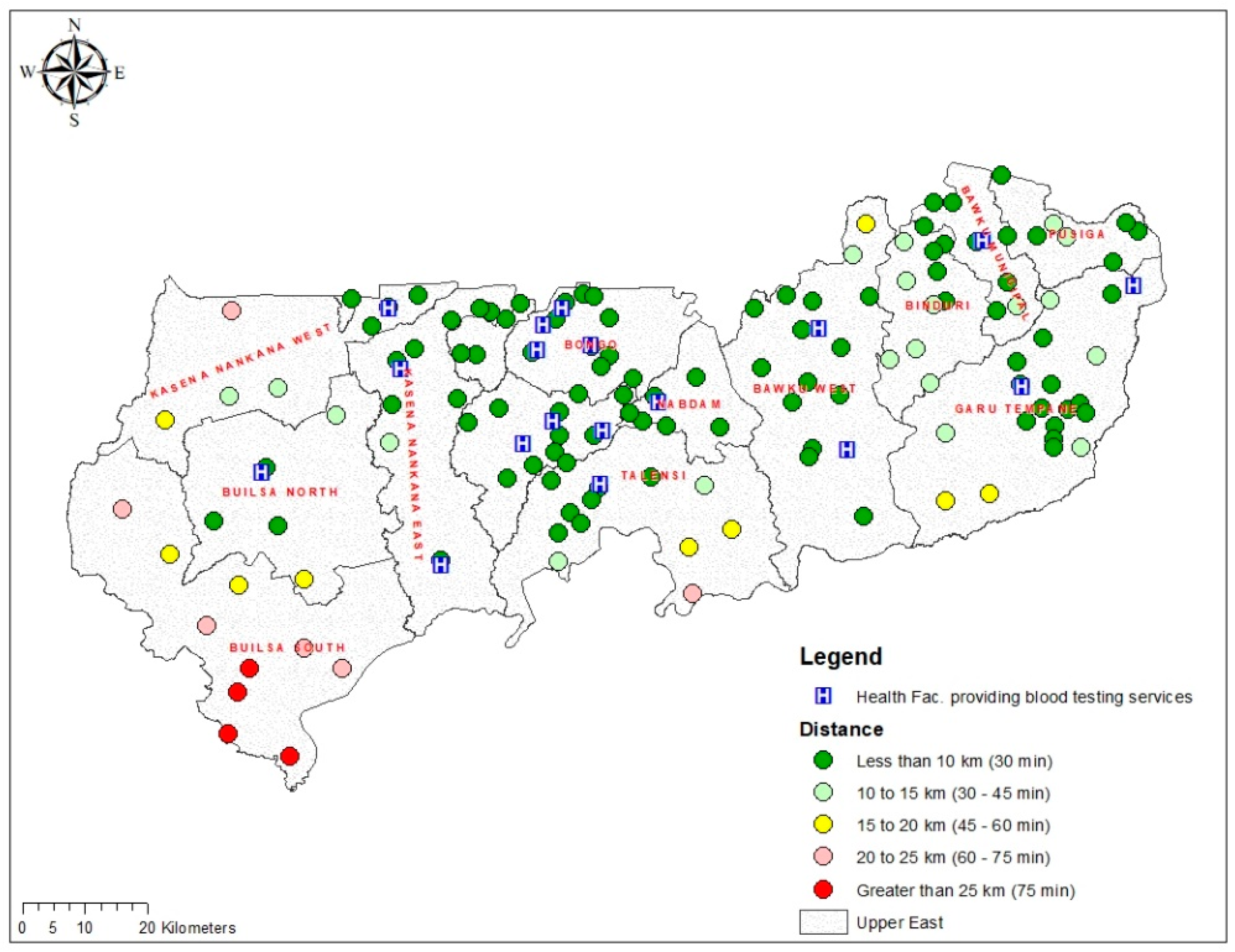
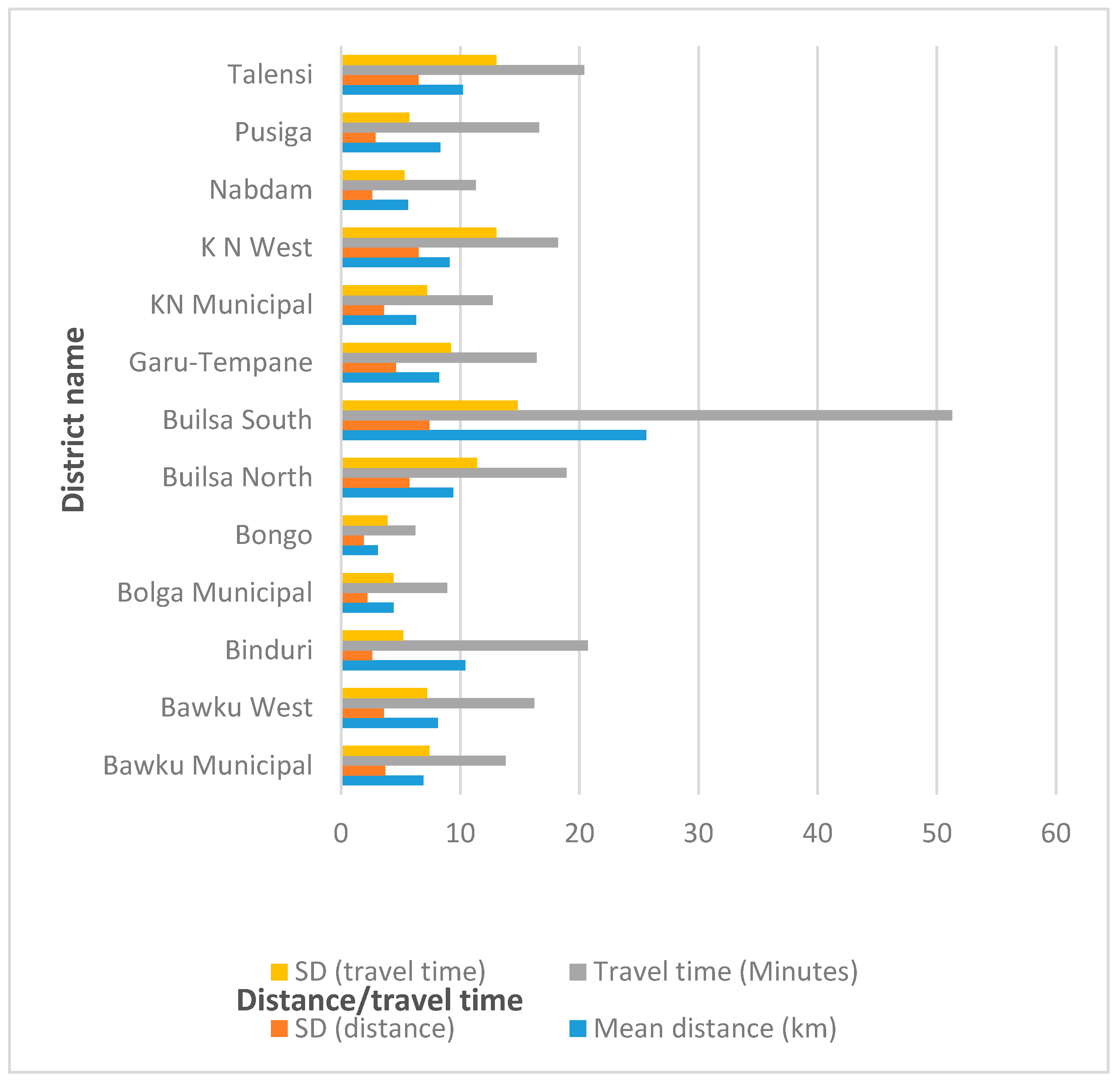
© 2019 by the authors. Licensee MDPI, Basel, Switzerland. This article is an open access article distributed under the terms and conditions of the Creative Commons Attribution (CC BY) license (http://creativecommons.org/licenses/by/4.0/).
Share and Cite
Kuupiel, D.; Adu, K.M.; Bawontuo, V.; Adogboba, D.A.; Mashamba-Thompson, T.P. Estimating the Spatial Accessibility to Blood Group and Rhesus Type Point-of-Care Testing for Maternal Healthcare in Ghana. Diagnostics 2019, 9, 175. https://doi.org/10.3390/diagnostics9040175
Kuupiel D, Adu KM, Bawontuo V, Adogboba DA, Mashamba-Thompson TP. Estimating the Spatial Accessibility to Blood Group and Rhesus Type Point-of-Care Testing for Maternal Healthcare in Ghana. Diagnostics. 2019; 9(4):175. https://doi.org/10.3390/diagnostics9040175
Chicago/Turabian StyleKuupiel, Desmond, Kwame M. Adu, Vitalis Bawontuo, Duncan A. Adogboba, and Tivani P. Mashamba-Thompson. 2019. "Estimating the Spatial Accessibility to Blood Group and Rhesus Type Point-of-Care Testing for Maternal Healthcare in Ghana" Diagnostics 9, no. 4: 175. https://doi.org/10.3390/diagnostics9040175
APA StyleKuupiel, D., Adu, K. M., Bawontuo, V., Adogboba, D. A., & Mashamba-Thompson, T. P. (2019). Estimating the Spatial Accessibility to Blood Group and Rhesus Type Point-of-Care Testing for Maternal Healthcare in Ghana. Diagnostics, 9(4), 175. https://doi.org/10.3390/diagnostics9040175





